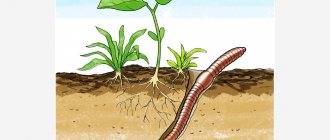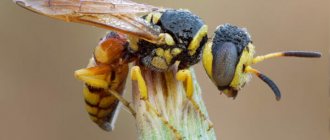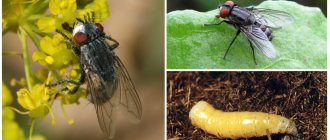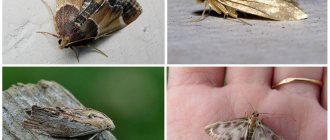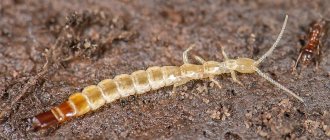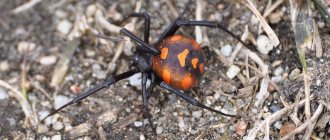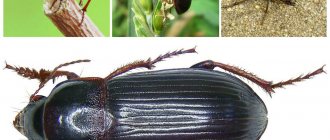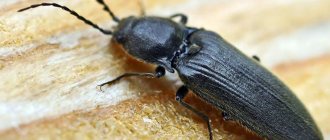What does a wireworm look like?
The body of the wireworm is elastic, dense and elongated, part of the integument on the abdomen is chitinized plates. The yellow or light brown body consists of a head and 9 segments: 3 thoracic and 6 abdominal.
The head is a quadrangle, narrowed in front, with rounded corners. There are 5 pairs of main setae on the frontal plate; different species may have additional setae. On the membranous base there are antennae consisting of 3 segments.
The pest has double jaws, the upper one is sickle-shaped with small teeth and 3 pairs of legs. All are equally developed and covered with hairs, bristles and small spines.
Adults have a flat body 7–20 mm long. The color of beetles can be dark brown, gray, brown, black with a metallic tint. Insects have a natural ability to make loud clicking sounds, turning over on their backs and jumping. For this feature they are called click beetles . Unlike larvae, adult insects feed little and do not cause significant damage to plants.
In our country, different types of beetles are common: dark, striped, shiny, steppe, Siberian, broad, sowing.
Description
There are two most dangerous enemies in the garden of agricultural crops, which are capable of destroying the crop if you do not wage war on them. One enemy attacks the top, the other operates underground. These are beetles: Colorado potato beetles and click beetles.
Moreover, the nutcracker is worse than the Colorado potato, in my opinion. You can see it and wage war openly, but the larvae of the second, living underground, can be much more dangerous.
This beetle, which has about 10 thousand varieties, is united under one name - “click beetle”. It has a distribution across all continents. His presence was seen even in the highlands, above five thousand meters.
These beetles were combined into one group due to the fact that when they jump, the beetle makes a very characteristic click. It is this sound that allows you to identify the pest in the garden.
All you have to do is flip the insect onto its back. The click beetle will immediately make a characteristic sound, turning over onto its stomach.
It is very important to know this feature of the click beetle, since they are very diverse in their appearance. These insects vary quite a lot depending on their habitat.
The size of the click beetle insect also differs: you can find individuals from a tiny size of 1 millimeter to large beetles that are up to 6 centimeters in length.
They are united by only two factors: in case of danger, they are able to make a jump and the similarity of the larvae, called “wireworms”.
Some types of click beetles:
- hairy
- ocellated
- Jamaican bioluminescent
Not much is known about the biological features. Most information is available about individuals living in Eurasia. Their American relatives have been little studied, and little is known about the inhabitants of the tropics.
But it has been precisely established that the insects themselves do not pose a danger to agronomy; only the larvae are the enemies of garden crops. Moreover, most of the wireworms (the larvae of this beetle) cause serious damage to agricultural crops. Other larvae are direct predators, devouring various living creatures underground.
Although wireworms vary in size and color, they are united by the presence of a chitinous hard shell and shape: they are all worms.
Because of their chitinous shell, these worms resemble pieces of wire—hence their name.
Perhaps the most vicious pests are wireworms of three varieties of click beetles:
- Dark Nutcracker
- Sowing striped
- Stepnoy
Wireworm larvae and adults
The development of the click beetle lasts 4–5 years . In the spring after wintering, female beetles lay small white eggs at the root collar of plants. Each clutch can contain 3–10 pieces. In 1 year, the female lays up to 200 eggs .
After 3–4 weeks, larvae 1.5–2.2 mm long emerge from them. The body of wireworms is initially light and transparent, and the head is yellow.
The insect spends 2–5 years in the wireworm larvae During the first year, the larvae grow up to 5 mm. For the winter they burrow 0.5 meters into the ground. The next year they continue to grow and develop.
Under unfavorable conditions, the larvae lag behind in development. The exact number of molts and generations of the wireworm cannot be determined. It depends on the type of pest, humidity, temperature, and availability of food. Most often, molting occurs 7–14 times, in the first year – 1 time and in subsequent years in spring and autumn. At the same time, larvae of different ages, ranging from 15 to 30 mm in length, can simultaneously be present in the soil at a depth of 10–12 cm.
In the first year, the larvae are inactive; as soon as they hatch, they feed on humus. The next year they change color to yellow or light brown and actively search for food. From this period, the wireworm becomes a dangerous pest.
The final transition from the perennial larval state to the adult stage occurs in June-August. Having finished feeding, the larvae pupate in the soil at a depth of 5–15 cm. After 2-3 weeks, young click beetles appear, which immediately go to winter and fly out of the ground, only next spring - in April-May, to begin a new breeding cycle.
Lifestyle
Adults lead an open lifestyle. They spend most of their time on plants, woody vegetation, or hide in secluded places - forest litter, manure, compost pit, wood cracks, bark, stones.
Throughout their adult life, adults do not feed at all or eat the green part of plants. Their main goal is to lay eggs. In one clutch it reproduces up to 1500 eggs, placing them in groups of 5 pieces.
Click beetle (wireworm)
On a note!
Wireworm larvae turn into adults within 5 years. From the second year they turn into real pests of agricultural crops. They are omnivorous, feeding on root crops, buds, and roots.
The wireworm chooses acidic soil for laying eggs. Infection of a site occurs due to non-compliance with crop rotation rules and improper care of the land.
Signs of plant infection
The voracious larvae of the click beetle damage seeds, roots, tubers and root crops of plants .
eat the embryo of the seeds , leaving a thin shell and deep holes on the sprouts. The pest gnaws holes in tubers and root crops and makes complex moves. This promotes the penetration of pathogens and decay.
In seedlings, the wireworm damages the tender roots and gnaws through the main stem . Plants wither and die.
The wireworm causes the greatest harm in spring and summer; at the beginning of autumn, the pest leaves for the winter.
What soils does wireworm like?
The number of pests is affected by soil moisture and salt concentration in it. Most species living in the central regions do not tolerate moisture deficiency well. Only steppe species are more resistant to fluctuations in soil moisture. During drought they go deep into the earth.
Click beetle larvae love acidic soils overgrown with weeds. In such places there is always a lot of food for them. Of the weeds, the most favorite are wheatgrass, quinoa, and thistle.
In saline areas, pests feel worse, since particles of ammonium, potassium and sodium damage their chitinous covers.
Thanks to its ability to migrate deep into the ground, the wireworm hides from harmful high temperatures and frosts. Although in the central regions the pest can survive for several days when the temperature drops to -6 to -10°C.
The wireworm prepares for wintering in advance. Within 2 months, the volume of water in the body decreases and the amount of glycogen increases.
What crops does the pest affect?
Wireworms damage the seeds and underground parts of many vegetable and ornamental plants.
Potato tubers, dahlias, gladioli, beet roots, carrots, strawberry roots, corn, daffodil bulbs, tulips, and iris rhizomes are subject to their invasion . Wireworms can chew through tomato .
Wireworm in potatoes
Wireworm in potatoes
Potatoes are the wireworm's favorite vegetable. Together with the Colorado potato beetle, these are the main crop pests. Once settled in a potato plot, wireworms can damage up to 60% of the tubers. Juicy potato roots are also a source of food for beetle larvae. Because of this, nutrition in the bushes is disrupted and the tuber yield is reduced.
Fungi, bacteria and nematodes settle through holes in the pulp. Damaged tissue around the passages turns black, and the tubers become inedible.
Traditional methods
Traditional methods are considered the most gentle measures. They include the use of various traps and herbal infusions.
Potato tubers or other root vegetables can become a trap for wireworms
Traps:
- Place half a potato or other root vegetable on the end of a 20 cm long branch and bury it to a depth of about 10 cm. After a few days, remove the trap and remove the wireworms. After refreshing the cut and moistening it, place the trap back in the ground.
- Bury jars up to half a liter in a shaded area up to the neck. You need to place pieces of potatoes or root vegetables in them. Check the traps every few days and replace the bait.
- Evenly distribute small piles of manure, potato tops or straw throughout the site. Pests prefer to live in them. After a week they must be destroyed.
- The remains of the kvass grounds should be placed in a nylon sock and buried, leaving the end on the surface. A few days later the trap is inspected.
Traps should be used before planting potatoes, as well as throughout the entire growing season of the plant.
Herbal infusions:
- 100 g of celandine is added to 10 liters of water. Let it brew for three days.
- 0.5 kg of nettle leaves are infused in 10 liters of water.
- 200 g of coltsfoot or dandelion are added to 10 liters of water.
Other recipes require about 12 hours to infuse. Afterwards, water the infected areas with herbal infusion. Carry out this watering once a week.
Crushed eggshells scattered around a summer cottage have a good effect. When planting, you can add onion peels and mustard powder; they have a repellent effect.
Planting corn or oats treated with any recommended insecticide is also an effective control measure. Sowing should be done several weeks before planting the main crops. Feeding on poisoned sprouts, the insect dies.
An important point in the fight against wireworms is timely weeding of the area. You should not leave plant debris between the beds; these are favorite places for their accumulation and reproduction.
The wireworm is considered a very dangerous pest that can ruin up to 60% of the crop. Only the use of an integrated approach to combating it will allow you to reduce its numbers and get a good and high-quality harvest on your plot.
How to get rid of wireworm?
Chemical and biological drugs
Bazudin
Contact insecticide based on diazinon. Destroys the pest by penetrating the intestines. The anti-wireworm drug is applied to the soil once when planting tubers. The depth of application of the product is 5–15 cm.
It is recommended to mix the drug with dry sand or sawdust before application. They fill a 1 liter container ¾ full and add 30 g of insecticide. Add 1 teaspoon of the working mixture to each well. The protection period lasts 15 days.
Zemlin
Granular preparation with odor. Used as bait for pests. It enters the insect's body along with food and poisons it from the inside.
When planting potatoes, bulbs and tubers of other plants, the drug is used in the same way as Bazudin. The product is mixed with sand or sawdust and applied to the soil when planting. 30 g of the drug is enough to treat 20–30 m².
Initiative
The insecticide is applied to the soil before sowing seeds, planting seedlings and planting material of vegetable and ornamental crops. 2 tsp. a mixture of dry sand and 30 g of the drug is added to each well. The product begins to act on the first day after application.
Prestige
A modern systemic contact drug based on imidacloprid. Once in the pest's body, it paralyzes and causes death. 20–25 ml of the product are diluted in 1 liter of water and sprayed on the planting material before planting.
Provotox
Granular preparation for soil application. The consumption rate of the drug is 40 g per 10 m². The insecticide is applied to the prepared soil after harvesting or during planting. Place 1–2 granules in each hole at a distance of at least 5 cm from the tubers or seeds. The product should not be used at temperatures above 25°C. The best time to use is in the morning from 9 to 10 o'clock or in the evening after 18 o'clock.
Metarizin
Bioinsecticide for the prevention and destruction of wireworms and other pests. Contains fungal spores from the genus Metarizium. After applying the drug to the soil, wireworms ingest fungal spores. They germinate in the intestines of the pest and spread throughout the body. Spores can germinate immediately in the soil and penetrate the body of insects through the chitinous cover.
The fungus releases substances that are toxic to the pest and the beetle larvae die. Spores emerge from decomposed remains and infect other pests. The protective effect lasts for several years.
Dissolve 0.5 liters of bioinsecticide in a bucket of water and water the soil with the solution when digging or hilling. The drug has a short shelf life; it must be used within 3 months after production.
Anthonem-F
An effective biological product based on nematodes. Together with irrigation water, nematodes enter the soil and then into the pest’s body. The product acts as an intestinal insecticide.
Inside the wireworm, nematodes multiply and after 8–15 days, thousands of new nematode larvae emerge from its body, capable of infection.
Only wet soil is treated with the biological product in the morning, evening or afternoon in cloudy weather. The air temperature should be between 10–28°C. Anthonem-F is capable of reducing the number of click beetle larvae by 95–100%.
Traditional methods
- When digging in spring, lime (120–150 g per 1 m²) or 20–25 g are added to the holes when planting. In acidic areas, this method solves two problems: it improves soil pH and fights wireworms.
- ash saves you from wireworms . 2–3 tbsp. l is added to each hole when planting potatoes and other vegetables.
- Before planting, tubers and bulbs are soaked in a decoction of onion peels . 1 kg pour 5 liters of water and bring to a boil. Use after cooling.
- Instead of onion broth, seedlings and tubers can be treated with a 1% solution of potassium permanganate .
- Mustard powder effectively fights wireworms . 1 teaspoon of powder is poured into the hole. In heavily infected areas, add a little hot red pepper .
- In small areas in the spring before planting, the use of bait . Pieces of potatoes, carrots, and beets are placed in moist soil at a depth of 5–10 cm. After 2–3 days, the baits are checked; if pests are present, the baits are doused with boiling water and the insects are destroyed.
Rules of struggle by folk means
Chemicals also harm beneficial organisms, so many people prefer to use plant-based substances - for example, celandine infusion. They are recommended to water the soil before planting.
Between the rows of plants, you can sprinkle the ground with wood ash. This leads to the death of the wireworm.
Also, adding nitrogen-containing fertilizers to the soil and watering with ammonia water have a good effect. This also allows you to fertilize the plants.
One relatively cheap but working method is crushed eggshells, which are scattered throughout the area;
For wireworms, bait is placed, using pieces of beets, carrots or cake, in holes to a depth of 7-15 cm, which are then covered with a layer of plywood or iron. After a few days, the lid is removed from the pits, and the larvae that have accumulated in them are burned. This procedure begins two weeks before planting crops and continues throughout the summer.
Prevention
- Autumn digging of the soil reduces the number of pests. The layer of earth is turned over and not broken into clods. In heavily infected areas, it is better to carry out this procedure later, on the eve of frost. Some larvae and adult beetles end up near the surface of the earth and die from low temperatures . In spring and early summer, when eggs are being laid, deep loosening . Detected beetles and their larvae are immediately removed from the ground and destroyed.
- Areas overgrown with weeds, especially wheatgrass and thistle, . The pest loves to feed on the roots of these herbs.
- The wireworm avoids places where legumes used to grow. This fact is taken into account when planning crop rotation. Beans and peas can be planted in rows around the perimeter of the site. Planting calendula and marigolds . The secretions of these plants discourage the wireworm's appetite.
- It is important to monitor the acidity of the soil. At elevated pH levels, lime the soil or add ash (2 liters per 1 m²). This worsens the living conditions of insects.
By carrying out prevention and systematic treatment of the soil with preparations, you can get rid of wireworms on the site in a few years.
More details: you will learn how to deal with wireworms from the video.
Preventive recommendations
A number of useful recommendations from specialists and experienced gardeners will help prevent the appearance of many pests on the site, including wireworms.
What to do:
- Timely removal of weeds will help in the fight against many pests.
- It is advisable to follow the rules of crop rotation so as not to plant the same crop in one place.
- In autumn and spring, it is better to dig deep into the soil on the site.
- It is better to plant leguminous plants interspersed in potato beds.
- An integrated approach to the fight against wireworms will help achieve a positive result.
Inaction on a personal plot or summer cottage in terms of pest control can lead to complete loss of the crop. If someone has a negative attitude towards toxic substances, then at least with the help of simple traps, it is still worth fighting pests. In addition, good results can be obtained if you use a number of agrotechnical measures. Mandatory planting of crops on the site that are not included in the wireworm’s diet also bears fruit. So, a little bit of each method and we can already say that pests are unlikely to feel comfortable on the site.
The wireworm is a click beetle. Description, control measures.
